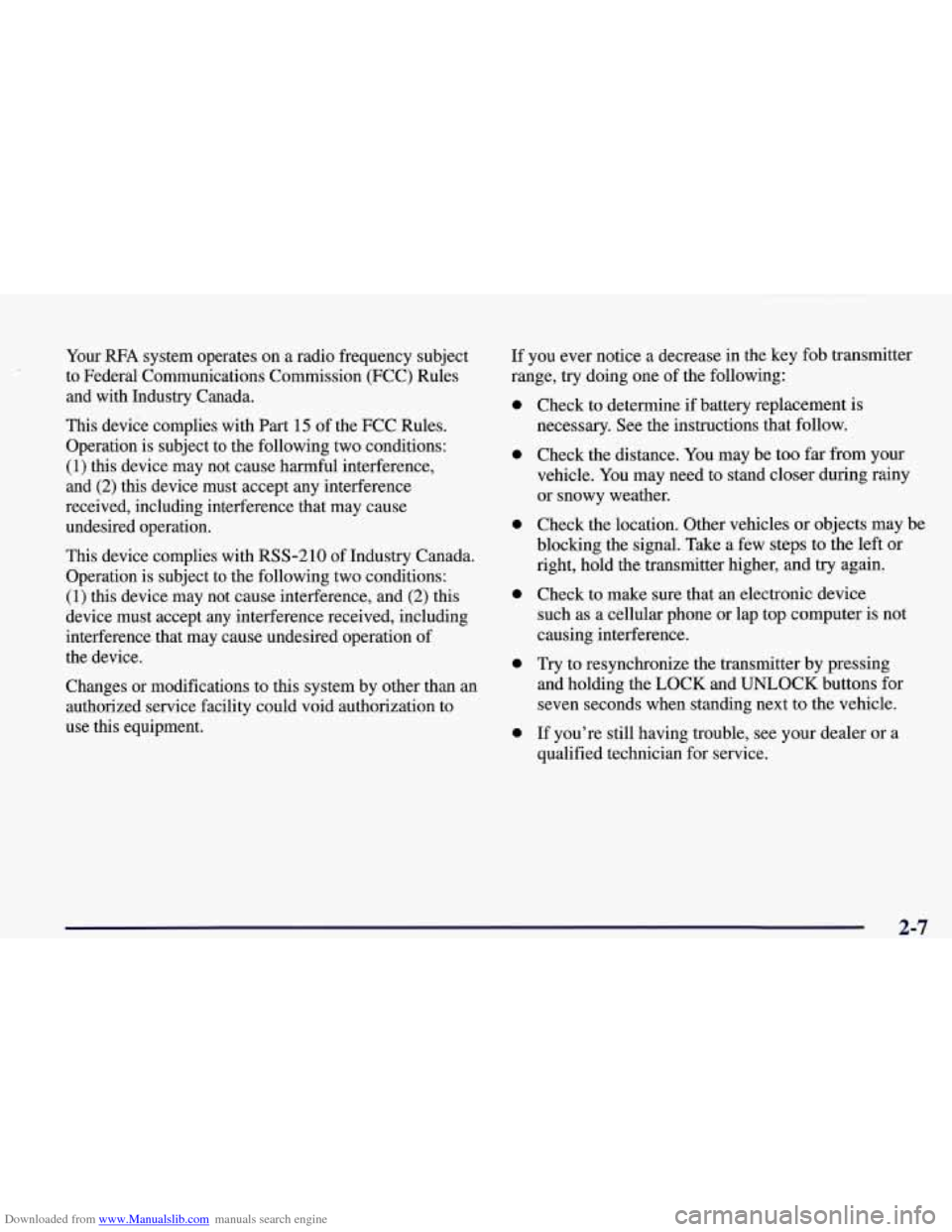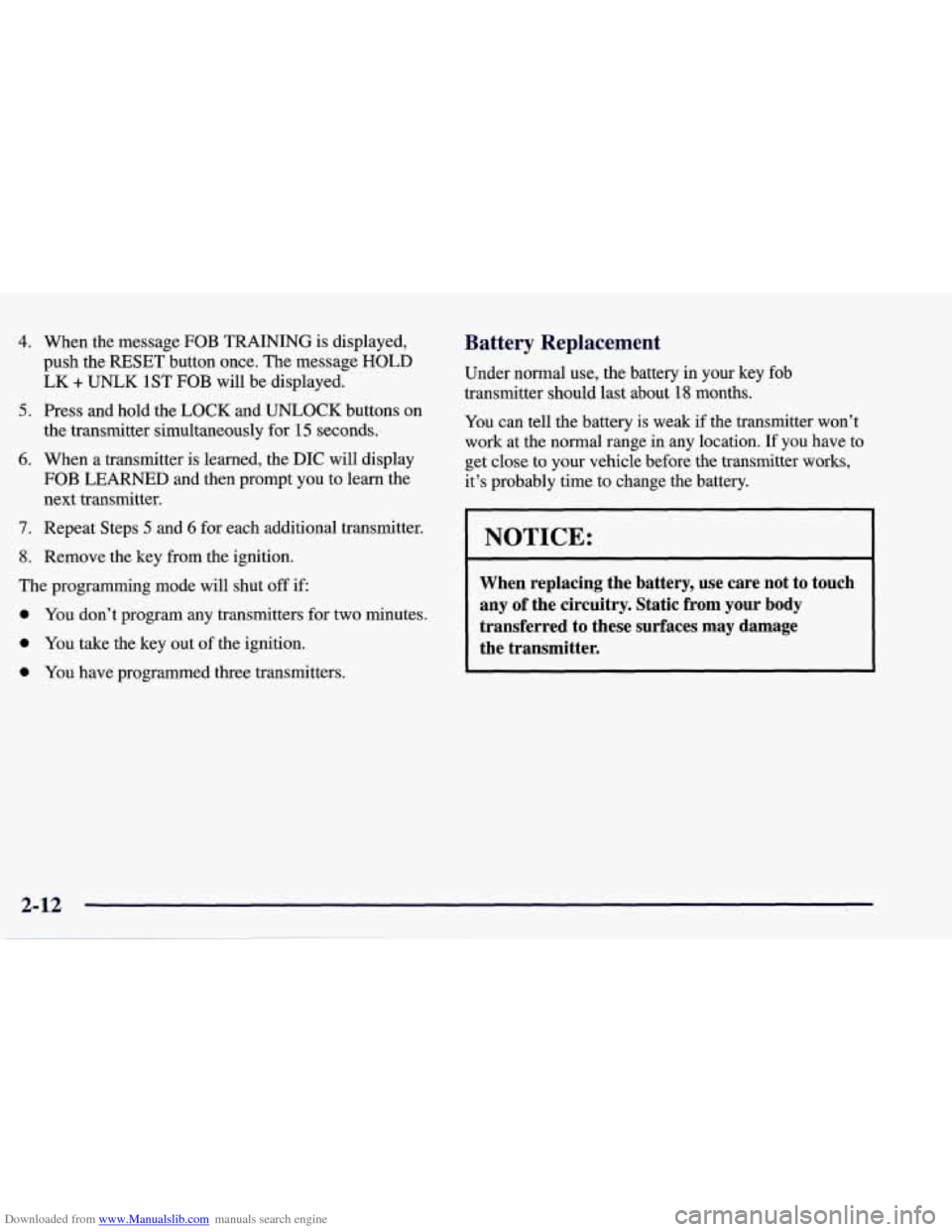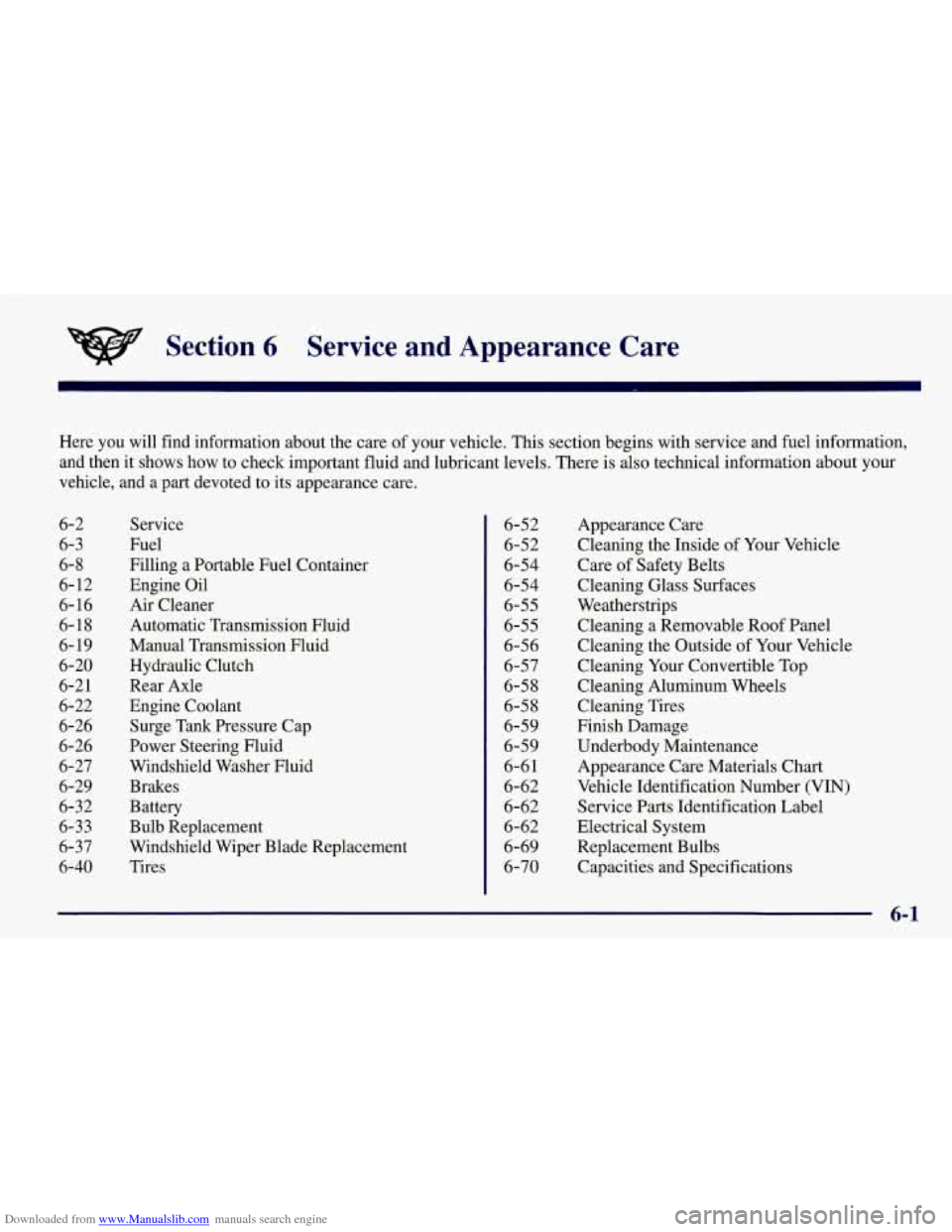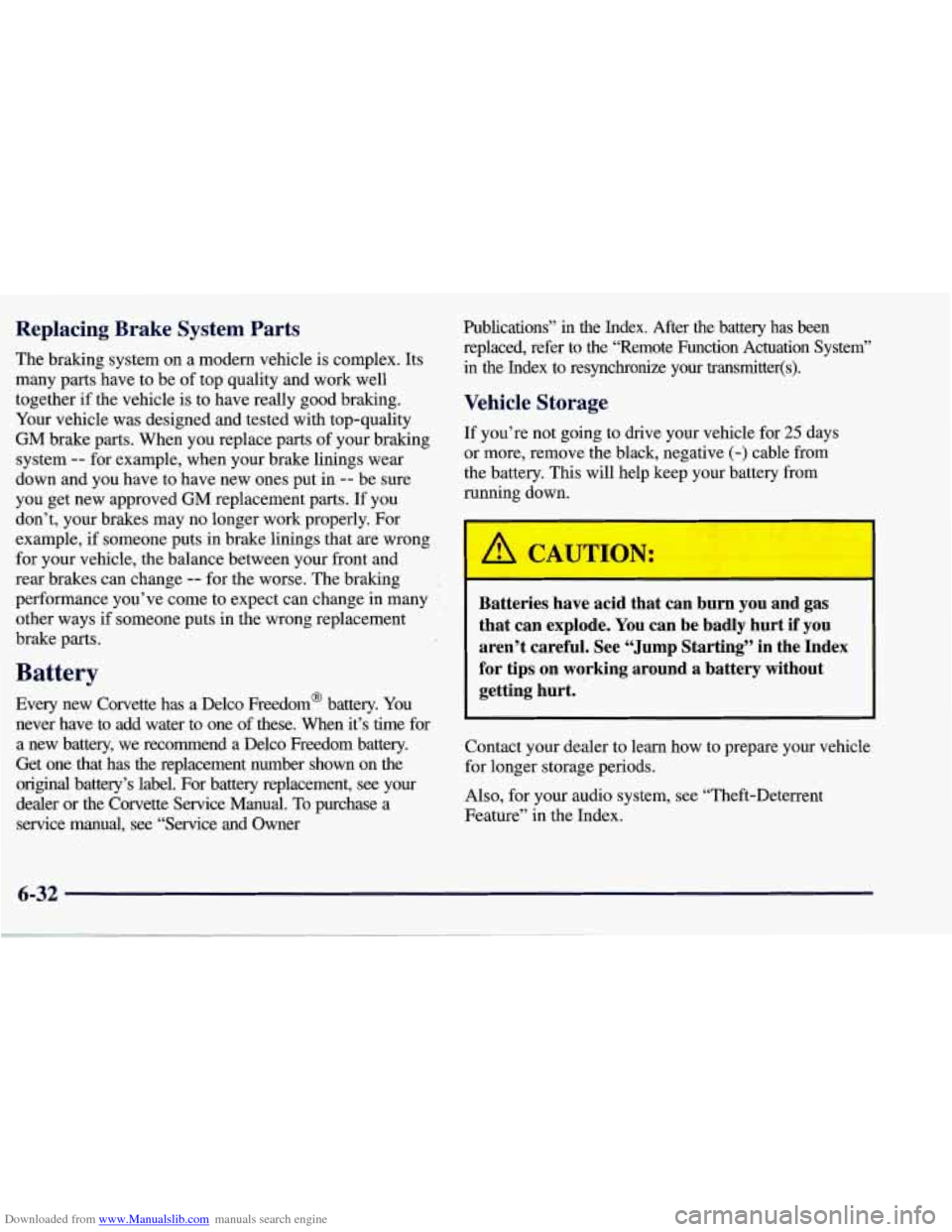1998 CHEVROLET CORVETTE battery replacement
[x] Cancel search: battery replacementPage 60 of 378

Downloaded from www.Manualslib.com manuals search engine Your RFA system operates on a radio frequency subject
to Federal Communications Commission (FCC) Rules
and with Industry Canada.
This device complies with Part
15 of the FCC Rules.
Operation is subject to the following two conditions:
(1) this device may not cause harmful interference,
and
(2) this device must accept any interference
received, including interference that may cause
undesired operation.
This device complies with RSS-210 of Industry Canada.
Operation is subject to the following two conditions:
(1) this device may not cause interference, and (2) this
device must accept
any interference received, including
interference that may cause undesired operation of
the device.
Changes or modifications to this system by other than an
authorized service facility could void authorization to
use this equipment. If
you ever notice a decrease in the key fob transmitter
range, try doing one of the following:
0
0
0
0
0
0
Check to determine if battery replacement is
necessary. See the instructions that follow.
Check the distance. You may be too far from your
vehicle. You may need to stand closer during rainy
or snowy weather.
Check the location. Other vehicles or objects may be
blocking the signal. Take a few steps to the left or
right, hold the transmitter higher, and
try again.
Check to make sure that an electronic device
such as a cellular phone or lap top computer is not
causing interference.
Try to resynchronize the transmitter by pressing
and holding the LOCK and UNLOCK buttons for
seven seconds when standing next to the vehicle.
If you’re still having trouble, see your dealer or a
qualified technician for service.
2-7
Page 64 of 378

Downloaded from www.Manualslib.com manuals search engine Resynchronizing Your Transmitter
Your RFA system uses a continually changing code for
increased security. Normally, the receiver in your
vehicle will keep track of this changing code.
,If your
vehicle does not respond to your transmitter, do the
following to determine what’s wrong:
1. Get closer to the vehicle and try pressing a button
again. Your battery may be low (If
so, see “Battery
Replacement” in the Index).
2. While standing close to your vehicle, press the
LOCK and UNLOCK buttons on your transmitter at
the same time and hold
for seven seconds. This will
attempt to resynchronize
the security code in your
RFA key fob transmitter.
3. When resynchronization is achieved, the horn
will chirp.
Loss of synchronization will occur after transmitter
battery replacement or disconnection of the
vehicle’s battery.
If attempts to resynchronize your transmitter to the
vehicle are not successful, you may need
to match the
transmitter to the vehicle.
Matching Transmitter(s) To Your Vehicle
Each key fob transmitter is coded to prevent another
transmitter from unlocking your vehicle.
If a transmitter
is lost or stolen,
a replacement can be purchased through
your dealer. Remember to bring any remaining
transmitters with you when you go to your dealer. When
the dealer matches the replacement transmitter to your
vehicle, any remaining transmitters must also be
matched. Once your dealer has coded the new
transmitter, the lost transmitter will not unlock your
vehicle. Each vehicle can have only three transmitters
matched to it.
To match transmitters to your vehicle:
1. Turn the ignition key to the ON position.
2. Clear any warning messages on the Driver
Information Center (DIC) by pressing the
RESET button.
3. Press the OPTIONS button on the DIC several times
until the blank page is displayed, then press and hold
the RESET button for two seconds.
2-11
Page 65 of 378

Downloaded from www.Manualslib.com manuals search engine 4. When the message FOB TRAINING is displayed,
push the RESET button once. The message
HOLD
LK + UNLK 1ST FOB will be displayed.
5. Press and hold the LOCK and UNLOCK buttons on
the transmitter simultaneously for
15 seconds.
6. When a transmitter is learned, the DIC will display
FOB LEARNED and then prompt you to learn the
next transmitter.
7. Repeat Steps 5 and 6 for each additional transmitter.
8. Remove the key from the ignition.
The programming mode will shut
off if
0 You don’t program any transmitters for two minutes.
0 You take the key out of the ignition.
0 You have programmed three transmitters.
Battery Replacement
Under normal use, the battery in your key fob
transmitter should last about
18 months.
You can tell the battery is weak if the transmitter won’t
work at the normal range
in any location. If you have to
get close to your vehicle before the transmitter works,
it’s probably time to change the battery.
NOTICE:
When replacing the battery, use care not to touch
any of the circuitry. Static from your body
transferred to these surfaces may damage
the transmitter.
2-12
Page 246 of 378

Downloaded from www.Manualslib.com manuals search engine Section 6 Service and Appearance Care
Here you will find information about the care of your vehicle. This section begins with service and fuel information,
and then it shows how to check important fluid and lubricant levels. There is also technical information about your
vehicle, and a part devoted to its appearance care.
6-2
6-3
6-8
6- 12
6- 16
6-18
6- 19
6-20
6-2
1
6-22
6-26
6-26
6-27
6-29
6-32
6-33
6-37
6-40
Service
Fuel
Filling a Portable Fuel Container
Engine Oil
Air Cleaner
Automatic Transmission Fluid
Manual Transmission Fluid
Hydraulic Clutch
Rear Axle
Engine Coolant Surge Tank Pressure Cap
Power Steering Fluid
Windshield Washer Fluid
Brakes
Battery
Bulb Replacement
Windshield Wiper Blade Replacement
Tires 6-52
6-52
6-54
6-54
6-55
6-55
6-56
6-57
6-58
6-58
6-59
6-59
6-61
6-62
6-62
6-62
6-69
6-70 Appearance Care Cleaning the Inside of Your Vehicle
Care of Safety Belts
Cleaning Glass Surfaces
Weatherstrips Cleaning a Removable Roof Panel
Cleaning the Outside of Your Vehicle
Cleaning Your Convertible Top
Cleaning Aluminum Wheels
Cleaning Tires
Finish Damage
Underbody Maintenance
Appearance Care Materials Chart
Vehicle Identification Number (VIN)
Service Parts Identification Label
Electrical System
Replacement Bulbs
Capacities and Specifications
6-1
Page 277 of 378

Downloaded from www.Manualslib.com manuals search engine Replacing Brake System Parts
The braking system on a modern vehicle is complex. Its
many parts have to be of top quality and work well
together
if the vehicle is to have really good braking.
Your vehicle was designed and tested with top-quality
GM brake parts. When you replace parts of your braking
system
-- for example, when your brake linings wear
down and you have to have new ones put in
-- be sure
you get new approved GM replacement parts. If you
don’t, your brakes may no longer work properly. For example,
if someone puts in brake linings that are wrong
for your vehicle, the balance between your front and
rear brakes can change
-- for the worse. The braking
performance you’ve come to expect can change
in many
other ways if someone puts in the wrong replacement
brake parts.
Battery
Every new Corvette has a Delco Freedom@ battery. You
never have to add water to one of these. When it’s time f\
or
a new battery, we recommend a Delco Freedom battery.
Get one that has the replacement number shown on the original battery’s label. For battery replacement, see your
dealer or the Corvette Service Manual.
To purchase a
service manual,
see “Service and Owner Publications”
in the Index. After the battery has been
replaced, refer to the “Remote Function Actuation System”
in the Index to resynchronize your transmitter(s).
Vehicle Storage
If you’re not going to drive your vehicle for 25 days
or more, remove the black, negative
(-) cable from
the battery. This will help keep your battery from
running down.
Batteries have acid that can burn you and gas
that can explode.
You can be badly hurt if you
aren’t careful. See “Jump Starting” in the Index
for tips
on working around a battery without
getting hurt.
Contact your dealer to learn how to prepare your vehicle
for longer storage periods.
Also, for your audio system, see “Theft-Deterrent
Feature” in the Index.
6-32
Page 315 of 378

Downloaded from www.Manualslib.com manuals search engine Capacities and Specifications
Engine
vpe .................................... V8
VIN Engine Code
LSl ...................................... G
Fuel Delivery ............ Sequential Multi-Port
Fuel Injection (SFI)
Valve Arrangement ............. Overhead Valve
Piston Displacement ...................... 5.7L
Bore ...................... 3.90 inches (9.9 cm)
Stroke .................... 3.62 inches (9.2 cm)
Compression Ratio
LSl ................................ 10.1:l
Horsepower
LS1 .................................. 345
Firing Order .................. 1-8-7-2-6-5-4-3
Thermostat Temperature
Specification
................... 187°F (86°C)
Replacement Parts
Air Cleaner Filter ...................... A917C
Battery ............................. 78A-72H
Coolant Surge Tank Cap ... GM Part No. 10296465
15 psi (105 kPa)
Engine Oil Filter ........................ PF44
PCV Valve ............................. 799C
Serpentine Belt
AC Compressor
......... GM Part No. 12556609
or equivalent
Water Pump, Generator, Power Steering Pump
... GM Part No. 12555225
Spark Plug ............. 41-93 1 (0.60 inch Gap) or equivalent
Thermostat ............. GM Part No. 12555717
or equivalent
Windshield Wiper Blade
Length ................... .22 inches (55.9 cm)
Type
............ 9 mm x 3 mm Shephard’s Hook
6-70
Page 356 of 378

Downloaded from www.Manualslib.com manuals search engine Section 9 Index
Accessory Outlet .............................. 2-59
Accessory Power Plug
........................... 6-63
Adding Equipment to the Outside of Your Vehicle
...... 6-3
AirBag
....................................... 1-18
How Does it Restrain
.......................... 1-23
How it Works ................................ 1-20
Location
............................... 1.20. 1-21
Servicing
................................... 1-24
What Makes it Inflate
.......................... 1-22
What Will
You See After it Inflates ............... 1-23
When Should it Inflate
......................... 1-22
Air Bag Readiness Light
.................... 1.20. 2.78
AirBagSystem
................................ 1-18
Aircleaner
.................................... 6-16
Air Conditioning
....................... 3.3. 3.7. 3.10
Alignment and Balance. Tire
...................... 6-48
Aluminum Wheels. Cleaning
...................... 6-58
Antenna Integrated
................................... 3-30
PowerMast ................................. 3-29
Antifreeze
..................................... 6-22
Anti-Lock Brakes
...................................... 4-7
Brake System Warning Light
................ 2.78. 4.7
Anti-Lock Brake System Warning Light
............. 2-80
Anti-Theft Radio
............................... 3-25
Appearance Care
............................... 6-52
Appearance Care Materials
....................... 6-6 1
Arbitration Program
.............................. 8-9 Ashtray
....................................... 2-58
Audio Equipment. Adding ........................ 3-27
Automatic
Audio Systems
................................. 3-12
Electronic Dual Climate Control System
............ 3-4
Overdrive
................................... 2-28
Transmission Check
........................... 7-12
Transmission Fluid ............................ 6-18
Transmission. Operation
....................... 2-26
Transmission. Park Mechanism Check
............ 7-14
Transmission. Shifting
......................... 2-26
Transmission. Starting Your Engine
.............. 2-22
Axle. Limited-Slip Rear
......................... 2-39
Axle. Rear
.................................... 6-21
Back-up Lamp Bulb Replacement
................. 6-37
Battery
....................................... 6-32
Jump Starting
................................. 5-3
Replacement. Remote Function Actuation (RFA) System
...................... 2-12
Warnings
................................ 5-3. 5-5
BBB Auto Line ................................. 8-9
Belt. Engine Accessory
.......................... 6-72
Better Business Bureau Mediation
................... 8-9
Blizzard
...................................... 4-26
Brake
Adjustment
.................................. 6-31
Fluid
....................................... 6-29
9-1